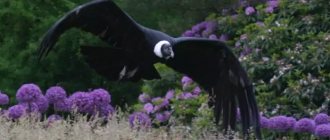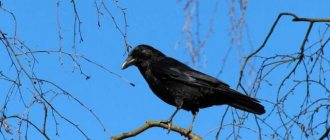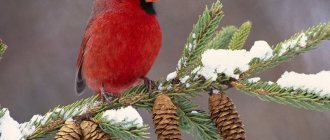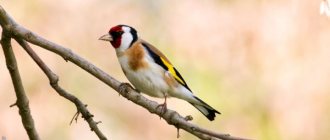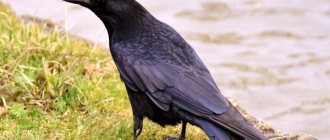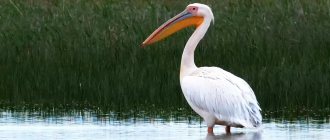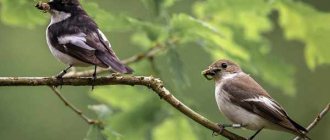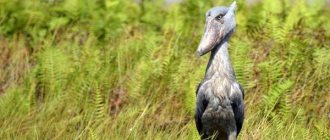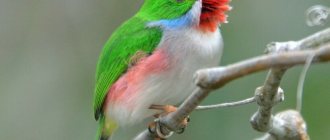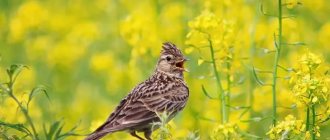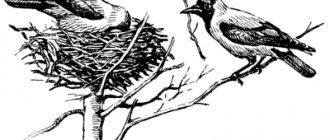- Wild animals
- >>
- Birds
The Andean condor is a South American bird in the family Cathartidae, the only branch of the genus Vultur. Found in the Andes mountains and adjacent Pacific coasts of South America. It is the largest flying bird in the world based on the combined measurement of weight and wingspan. Its maximum wingspan is 3.3 m, exceeded only by the wingspan of four seabirds and waterfowl - albatrosses and pelicans.
Origin of the species and description
Photo: Andean condor
The Andean condor was introduced by Swedish naturalist Carl Linnaeus in 1758 and retains its original binomial name Vultur gryphus to this day. The general term Vultur is taken directly from the Latin vultur, meaning "vulture". Its specific epithet comes from a variant of the Greek word γρυπός (grupós, "hook nose").
Interesting fact: The exact taxonomic placement of the Andean condor and the remaining six species of New World vultures remains unclear. Although vultures on all continents are similar in appearance and have similar ecological roles, they still originated from different ancestors in different parts of the world and are not closely related. Scientists are discussing how different these two families are today.
The Andean condor is the only recognized living species of its genus, Vultur. Compared to the California condor (G. californianus), which is known from numerous fossils and some additional relatives, fossil records of the Andean condor are very sparse.
It is assumed that the early Pleistocene species of South American condors were not very different from the current species. Although one specimen extant from only a few rather small bones found in a Pliocene deposit in the department of Tarija, Bolivia, may have been a smaller subspecies, V Gryphus Patruus.
LIFESTYLE
The condor inhabits mountainous areas. He chooses places for resting and nesting on inaccessible, bare rocky cornices that rise several hundred meters above the ground. Nature has equipped the condor very well for this lifestyle. The Andean condor has a wingspan of approximately 3 m, making its wingspan only slightly smaller than that of the wandering albatross, whose wings have the largest supporting surface. During flight, the condor uses rising warm air currents, therefore, once in the air, it can effortlessly soar and circle in the sky for hours. When a bird wants to change the direction of flight, it does this with the help of the first row of flight feathers. By opening and contracting the primary flight feather, the bird passes air currents through it and thanks to this it maneuvers. The condor has been seen at an altitude of 5,000 meters above sea level, but usually the bird stays at an altitude of up to 3 thousand meters. When the condor wants to fall to the ground, it extends its legs forward.
Appearance and features
Photo: What an Andean condor looks like
Andean condors have black, shiny plumage with a white collar around the base of their necks. While in juveniles the plumage is olive-gray and brown. These birds also have white feathers on their wings, and in males they are more pronounced. Adult condors have no feathers on their necks or heads and are typically black to dark reddish brown in color. The cubs have gray fluff in these places, which subsequently disappears. This baldness is probably a hygienic adaptation, since bare skin is easier to keep clean and dry after feeding on carrion.
Video: Andean condor
The beak is used to tear rotting meat from the corpse. The bases of their upper and lower jaws are dark, while the rest of the beak is ivory-colored. Andean condors weigh from 7.7 to 15 kg and have a length of 97.5 to 128 cm. The legs of Andean condors are much less powerful and have blunted short claws, unlike other birds of prey. The hind toe is less developed, but the middle toe is much longer than the others. Their feet and legs are covered with round, dark gray scales.
Fun fact: The 3.2 m wingspan is the longest wingspan of any land bird.
Andean condors are the only species in the family Cathartidae that exhibit dramatic sexual dimorphism. Unlike many other birds of prey, male Andean condors are significantly larger than females. In addition, males have a large crest, which females do not have. The sexes of birds also differ in eye color, with males having brown pupils and females having red pupils. Both sexes have the ability to change the color of bare skin on the neck and face depending on their mood. This is used for communication between individuals and for displays during mating season.
Now you know where the Andean condor lives. Let's see what he eats.
Common types
California condor (Gymnogyps californianus)
The wingspan of the California condor is up to 3 meters. Body length reaches 125 cm, weight does not exceed 14 kg. The plumage is black with white feathers on the belly; on the neck of the bird there is a black collar with sharp feathers that stick out in different directions. The beak is short and strong.
The species is very rare, found in the mountains of California, Arizona, Utah and Mexico. Previously, the California condor lived throughout the North American continent. But with its beautiful flight, the bird attracted the attention of hunters, which is why it was on the verge of extinction. In 1987, the last condor living in the wild was caught, and the total number of birds at that time reached 27 individuals. Fortunately, condors reproduce well in captivity, and already in 1992 the birds began to be released into the wild.
Where does the Andean condor live?
Photo: Andean condor bird
The condor is found in South America in the Andes, plus the Santa Marta Mountains. From the north, its range begins from Venezuela and Colombia, where the bird is extremely rare, then stretches south along the Andes of Ecuador + Peru + Chile, bypassing Bolivia and Argentina all the way to Tierra del Fuego. In the 19th century, the Andean condor was found everywhere from Venezuela to Tierra del Fuego, but the range was significantly reduced due to human activity.
Interesting fact: In an isolated network of mountain peaks in the Andes of Colombia and Ecuador, bird numbers are believed to be declining. Populations reach much higher densities in regions south of the northern Peruvian Low, where they inhabit large areas of high prairie, desert, and coastal areas.
Its habitat mainly consists of open grasslands and alpine zones up to 5000 m altitude. It prefers relatively open, unforested areas that allow it to spot carrion from the air, such as páramo or rocky mountainous areas. Andean condors live and nest on cliffs in small rock outcroppings or caves. They use heat currents to take off and hover for hours without much effort in search of food.
Sometimes the Andean condor is found in the lowlands of eastern Bolivia, northern Peru and southwestern Brazil, the bird descends into the desert lowlands of Chile + Peru and is found in southern beech forests in Patagonia. In southern Patagonia, grasslands are important for Andean condors because herbivores may be present in this habitat. In this region, the range of Andean condors is influenced by the presence of grasslands as well as cliffs for nesting and roosting.
Social behavior
Andean condors live in separate pairs at considerable distances from each other; pairs last a lifetime. These scavengers encounter other birds only during feeding, when smaller species help them find prey, and they, in turn, by tearing the skin of the corpse, make it more accessible to others. In this case, apparently, there are no particularly antagonistic clashes. If several condors gather near the prey, then older birds dominate over young ones, and males dominate over females.
What does the Andean condor eat?
Photo: Great Andean condor
These vultures often cooperate in mutually beneficial hunting relationships with turkey vultures and black catharts, which search for prey by scent, while Andean condors detect food by sight. Large Andean condors are much better suited to tearing the tough hide of a freshly killed or deceased animal. Smaller vultures benefit from the condor's labor and feed on what's left of the newly found carcass.
During the last century, there has been an ecological change in the availability of common foods for native species across much of the Andean condor's range. All of them are being replaced by domesticated animals such as cows, horses, sheep, goats. And also those used for sport hunting (rabbits, foxes, wild boars and deer).
The original foods of Andean condors included:
- llamas;
- alpacas;
- rhea;
- guanaco;
- armadillos.
These prey species are now being replaced by domestic animals. Andean condors also feed on the carcasses of whales and other large marine mammals in coastal areas. They are primarily scavengers, but occasionally hunt marmots, birds and rabbits, and sometimes raid the nests of small birds to eat eggs.
Andean condors lack well-developed hunting techniques, but they can stalk and capture live prey, in which case they begin feeding before the animal dies. Andean condors hold prey by standing on it, as they lack the strong prehensile legs that most hunting predators have.
Interesting fact: When approaching a fresh carcass, Andean condors often begin to rip apart the animal near the anus and move towards the head. The first thing eaten is usually the liver, then the muscles. No significant attempts were made to open the skull and eat the brain.
In the northern parts of their range, Andean condors are experiencing a sharp decline in numbers associated with food problems. Andean condors often go several days without food, then eat large amounts of food so much that they cannot rise into the air. They occupy an important part of the ecosystem by eating carrion that would otherwise become a breeding ground for disease.
Nutrition and feeding behavior
The basis of food for Andean condors is the corpses of dead animals. In search of food, they fly over large areas, covering up to 200 km per day. Often condors search for prey on the ocean coast, where they eat not only the corpses of marine animals, but also collect eggs and chicks of sea colonial birds. When searching for prey, they are guided by their excellent vision, and also carefully observe the behavior of other scavengers, such as ravens and catharts (smaller birds of prey in the same family of American vultures). Such joint searches for prey are usually beneficial for all participants: ravens and catharts help condors find prey, and they, in turn, tearing the skin of a corpse with their powerful beaks, make it available to smaller and weaker predators. Since condors cannot carry away prey, they are forced to feed only at the place where it is found. Sometimes birds eat so much at one time that they cannot even fly right away; but then they may not eat at all for several days. Like other scavengers, condors play an important role in ecosystems by reducing the spread of disease.
Features of character and lifestyle
Photo: Andean condor in flight
These are monogamous birds that mate for life. They are active during the day. Both adults and juveniles, the birds live together on ledges and slabs to rest, but do not breed there as other vultures do. Large numbers (over 196) of condors have been spotted in public areas in Patagonia and Argentina. The use of recreational facilities increases in the summer and fall.
Social interactions at roosting sites exhibit a dominance hierarchy, with males dominant over females and adults dominant over juveniles. This dominant behavior has led to the division of roosting sites, with birds higher in the hierarchy preferentially occupying the best sites with optimal sun exposure and wind protection.
Fun Fact: Like many New World vultures, Andean condors have a habit of defecating on their feet, resulting in the bird constantly walking around with its feet covered in white accumulations of uric acid. Some scientists suggest that this provides a cooling effect on the legs and feet. However, this makes no sense in the bird's cold Andean habitat.
When the Andean condor takes flight, its wings are held horizontally and its primary feathers are folded upward at the tips. It flaps its wings when rising from the ground, but once it reaches a moderate level of altitude, it very rarely continues to flap its wings, relying on thermal properties.
Condor (bird): photos, interesting facts
For the peoples inhabiting the Andes, the condor is a symbol of health and strength. According to ancient belief, the bones of this giant, as well as his other organs, have healing properties. Because of this, people thoughtlessly exterminated birds, without thinking about the consequences.
In Indian tribes, the Andean condor (bird) is associated with the sun deity; the Indians consider him the ruler of the upper world. Even 2.5 thousand years BC there were already rock paintings depicting this giant.
Social structure and reproduction
Photo: Andean condor
A pair of Andean condors can choose a nest site and then live near it for two and a half months before mating begins. When the time for laying eggs begins to approach, the female begins to gradually sit closer to the ledge of the nest until she remains to spend the night inside it.
Before mating, the male begins by spreading his wings and inflating his neck. Its neck and crest become a bright gray-yellow color. He approaches the female with her wings spread and her neck extended and curved. The male makes slight turns left and right as he approaches the female, who may also spread her wings and imitate his behavior. Courtship and mating are inextricably linked to the male's role as the dominant partner and the female's subordination to him.
Fun fact: Mating season varies geographically, but is generally from February to June. Andean condors are non-migratory birds, so seasonal routines vary greatly between the northern and southern reaches of their range. The breeding interval also likely varies depending on habitat quality and food availability.
Most Andean condors do not build nests, but instead lay a single egg on a bare cliff ledge. Some members of the species collect several sticks to scatter along the ledge. The eggs are bluish-white in color, weigh about 280 g and have a length of 7.6 to 10.1 cm. One egg is incubated for 54-58 days. Both parents care for the chicks until they fly away at 6 to 7 months of age. The chicks remain with their parents until they are 2 years old, when the pair begins to breed again. Puberty occurs at 6-11 years of age.
Appearance description
Condors are covered with black feathers - the main color; in addition, the body is decorated with white feathers. Their bare, fleshy heads are the perfect adaptation for feasting on carrion: the lack of feathers allows condors to poke their heads into animal carcasses without getting too dirty. Loose folds of reddish-black skin hang over the head and neck. Condors are sexually dimorphic, with males having a scarlet crest, called a caruncle, above their beaks.
Natural enemies of Andean condors
Photo: Andean condor bird
Healthy adult condors have no known natural predators. Young chicks can become victims of large birds of prey or foxes. Eggs can rarely be taken by predators because... One of the parents is always in the nest. In addition, Andean condors nest on high, inaccessible cliff ledges, where they are protected from any attacks. But sometimes these birds nest in places that are more accessible to penetration by land. They are known to aggressively defend their nest from potential predators.
Main predators:
- foxes;
- predator birds.
Andean condors tend to feed on large dead animals and sometimes prey on sick and injured fauna. Most of the native species in the Andean highlands have been replaced by domesticated species such as llamas, cows, horses, sheep and goats, which now make up the majority of the condor's diet. This has led some farmers and ranchers to view them as pests that plague their livestock.
Bird poisonings have been common over the last hundred years, but are now becoming less common due to increased public awareness and recognition of Andean condors as symbols of the region. In the ancient Inca culture of Peru, the condor represents one of the three realms of existence - the heavens; while the jaguar represents the earth and the snake the underworld. These three cultural references appear throughout Inca society, including in their architecture.
Bird feeding
The condor is a bird that is included in the honorable order of nature's orderlies. And, of course, there are reasons for this. It's all about nutrition. Condors prefer to feast on the decaying carcasses of dead animals. Although they are predators, they do not like living blood.
True, in some cases, such birds eat the chicks and eggs of some birds, attacking their colonies. The condor is also capable of attacking mountain goats and deer. Sometimes he actually steals small livestock, within reason, of course.
Condor attack on a wolf
Such birds are not aggressive towards their relatives, so fights over prey usually do not occur. They usually go hunting at dawn. In the mountainous areas where such predators live, any prey is rare.
Therefore, you can spend a lot of time searching for it. And if the condor is lucky enough to eat, he tries to fill his stomach in reserve. Moreover, he does not know how to hide the surplus, and he is also not able to take food with him. But the next day the food may go wrong, and the bird will remain hungry. This is why we have to resort to extreme measures.
It happens that these predators eat so much that they are then unable to fly. But this does not matter; having been thoroughly satiated, the condor has every chance of fully existing for several days without food. Therefore, after a sumptuous meal, he has nowhere to rush.
Population and species status
Photo: What an Andean condor looks like
This species has a relatively small global population, which is suspected to be declining rapidly due to human persecution. Consequently, it is classified as critically endangered. It is threatened mainly in the northern part of its range, and very rarely in Venezuela and Colombia. Because the bird has very low mortality, but extremely low reproductive rates.
The species is very vulnerable in some parts of its range because people persecute the bird due to attacks on livestock. Increased tourism in parts of Chile and Argentina has led to a reduction in persecution, demonstrating the value of the species for ecotourism. Poisoning of mountain lions and foxes as a result may affect the species in some regions. In Argentina, condors rely heavily on the carcasses of exotic herbivores, which make up 98.5% of their diet, making them vulnerable to changes in livestock production. Interspecific competition for carcasses in the same areas can have detrimental effects on condor populations.
Andean condors are one of the world's largest flying birds. Their survival in their natural habitat is important for ecotourism. Andean condors are also often found in zoos, being a popular exhibit animal due to their status. They were an important training resource for zoos to gain experience with the challenges of breeding large condors in captivity.
The story of life at the zoo
One of the most famous animals of the Moscow Zoo is certainly the Andean condor named Kuzya. He came to the zoo as an adult bird in 1892 or 1893. and lived until the 1960s. In the archives of our zoo there are several photographs depicting Kuzya walking freely along the alleys on the zoo’s day off. He was such an outstanding personality that since then, in memory of him, all Andean condors at the Moscow Zoo were given the nickname Kuzya.
Now another Kuzya lives in the zoo, who is over 35 years old and who came to Moscow from nature from Argentina. (Animals from nature are especially prized in zoos). The female also came with him, and in 1996, 1 chick was obtained from them. However, the female died, and Kuzya lived alone for a long time. At the end of 2014, a 14-year-old female named Sweetheart was brought from one of the French zoos (she really has a very sweet character). Now the condors are sitting in neighboring enclosures and getting used to each other (through the bars for now). We hope that over time they will form a strong married couple.
The daily diet of a condor at the Moscow Zoo includes 1.5-1.7 kg of meat, 200 g of fish and 1-2 rats.
CONDOR - A HOCKEY PLAYER CAUSED A TROUBLE AT THE MATCH. Video (00:02:28)
The championship match of the semi-professional overseas Hockey League of the East Coast was almost disrupted because of the hosts' mascot - a live condor. During the performance of the American anthem, a giant bird flew off the trainer's shoulder and decided to take a walk on the ice. He gave chase and overtook his pet at the feet of the singer, but slipped and let go of the condor. Having regained its freedom, the bird, amid the hooting of the spectators, resolutely headed to the substitutes' bench and, pushing aside the frightened Condors players who were there, suddenly attacked their head coach.
